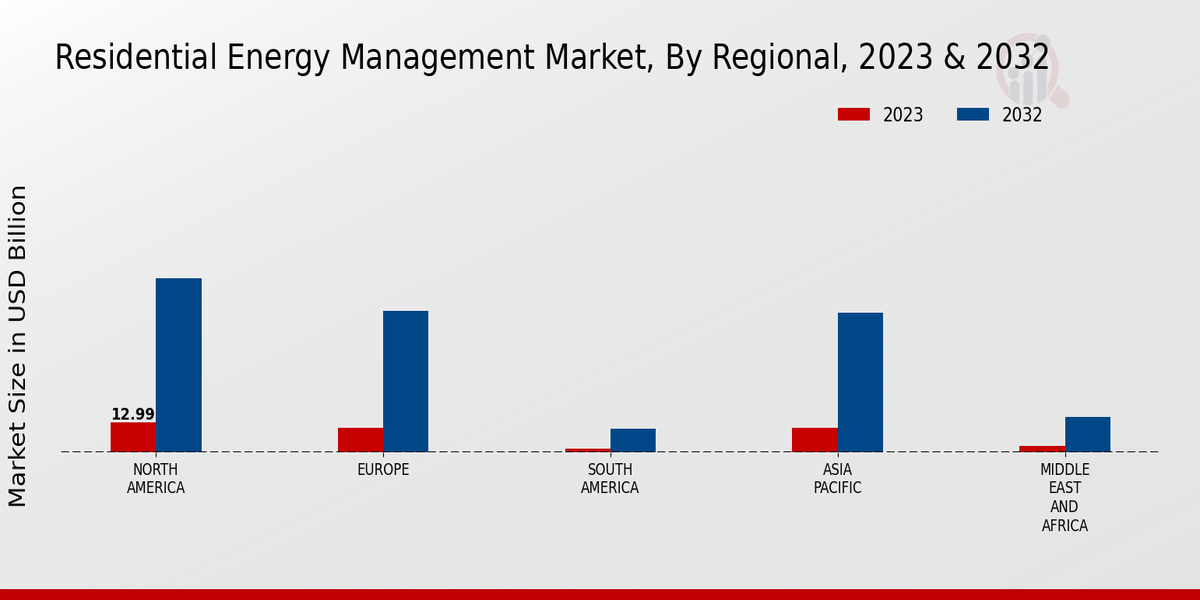Rising Energy Costs
The continuous rise in energy costs is a significant driver of the Global Residential Energy Management Market Industry. As utility prices increase, homeowners are more inclined to seek solutions that help manage and reduce their energy expenditures. This trend is particularly evident in regions where energy prices have surged, prompting consumers to invest in residential energy management systems. The market's growth is further supported by the increasing availability of energy-efficient products and services that promise long-term savings. Consequently, the demand for energy management solutions is expected to rise, aligning with the projected market size of 48.8 USD Billion in 2024, as consumers prioritize cost-effective energy management.
Market Growth Projections
The Global Residential Energy Management Market Industry is poised for remarkable growth, with projections indicating a market size of 48.8 USD Billion in 2024 and an anticipated expansion to 418.6 USD Billion by 2035. This trajectory suggests a compound annual growth rate of 21.58% from 2025 to 2035. Such growth is driven by various factors, including technological advancements, government incentives, and increasing consumer awareness regarding energy efficiency. The market's evolution reflects a broader trend towards sustainable living and energy management, as homeowners increasingly seek solutions that align with their environmental values and economic interests.
Growing Demand for Energy Efficiency
The increasing global emphasis on energy efficiency drives the Global Residential Energy Management Market Industry. Homeowners are increasingly seeking solutions that reduce energy consumption and lower utility bills. This trend is underscored by the projected market size of 48.8 USD Billion in 2024, reflecting a growing awareness of energy management technologies. Governments worldwide are implementing regulations and incentives to promote energy-efficient appliances and systems, further propelling the demand for residential energy management solutions. As consumers become more environmentally conscious, the adoption of smart home technologies that optimize energy use is likely to surge, contributing to the market's expansion.
Advancements in Smart Home Technology
Technological advancements in smart home devices significantly influence the Global Residential Energy Management Market Industry. Innovations such as smart thermostats, energy monitoring systems, and automated lighting solutions enhance energy management capabilities for homeowners. These technologies not only provide real-time data on energy consumption but also allow for remote control and automation, leading to improved energy efficiency. The integration of artificial intelligence and machine learning in these devices further enhances their functionality, making them more appealing to consumers. As the market evolves, the adoption of these smart technologies is expected to accelerate, contributing to the projected growth of the market to 418.6 USD Billion by 2035.
Government Incentives and Regulations
Government initiatives play a crucial role in shaping the Global Residential Energy Management Market Industry. Various countries are implementing policies and incentives to encourage the adoption of energy-efficient technologies in residential settings. These initiatives often include tax credits, rebates, and grants for homeowners who invest in energy management systems. Such support not only lowers the financial barrier for consumers but also promotes awareness of energy conservation practices. As a result, the market is likely to experience substantial growth, with a compound annual growth rate of 21.58% projected from 2025 to 2035. This regulatory environment fosters innovation and competition among energy management solution providers.
Increased Awareness of Environmental Impact
Growing awareness of environmental issues significantly influences the Global Residential Energy Management Market Industry. As climate change concerns escalate, consumers are increasingly motivated to adopt sustainable practices, including energy conservation at home. This shift in consumer behavior is driving the demand for residential energy management solutions that promote eco-friendly energy use. The market is expected to benefit from this trend, as more homeowners seek technologies that not only reduce their carbon footprint but also enhance energy efficiency. The projected growth of the market to 418.6 USD Billion by 2035 indicates a strong alignment between consumer values and energy management solutions, fostering a more sustainable future.




















